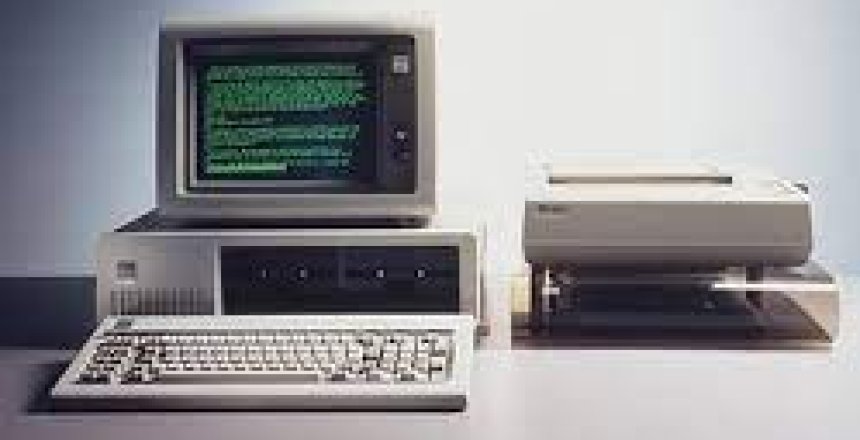These days we take a lot for granted, like the mouse and the hard drive in our computers but they haven’t always been there. IBM for example with their 5150 otherwise known as the IBM PC was going to ship this with a cassette recorder and came with a cassette recorder input on the back.

The floppy disk
The technology behind the floppy disk comes from the 1960s, as does a lot of computer technology. IBM’s Alan Shugart who later founded Shugart Associates to make 8″ drives for other manufacturers was responsible for this drive. Later he would be influential in the 5.25″ drives and the standard his company would create to connect drives to computers.
Sony created the 3.5″ drive in 1981, and the Microfloppy Industry Committee, a consortium of 23 manufacturers in 1982 pushed the 3.5″ floppy drive to the masses.
IBM only implemented the 3.5″ drive in it’s Personal System/2 (PS/2) which also brought us the universal keyboard and mouse interface.

CD-ROM/DVD/Blu Ray Drive
Laserdisc was invented in 1958 and was the first optical storage medium. This was later enhanced by James Russell in 1972 to create the first digital optical recording which later became the basis for a compact disc in 1980 through Philips and Sony.
By 1983 the erasable CD-R had been developed but only became popular in the 1990s.
The first PC CD-ROM was Philips CM100 which was released in 1985 and had to be connected via an expansion card and a serial interface. Later it was realised that CD-ROMs could be scratched easily so most PC CD drives had to be loaded into a caddy before they could be used, this continued into the mid 1990s when tray loaders became more popular.
In 1995, the laserdisc evolved into the Digital Video Disc or DVD.
There were two conflicting formats for DVD recordables, DVD-R and DVD+R which later lead to DVD-RW and DVD+RW.
This was followed by HD-DVD and BluRay and the format wars that started in 2008, similar the VHS/Betamax video war before then, the victor was BluRay.
While BluRay was popular as a format for TV viewers, the technology wasn’t as successful with PCs, since the cost of the writer was 10 times the cost of DVD and the reader was 3 times the cost.
With the advent of streaming and downloadable content, new computers don’t come with DVD drives and so their cases can be smaller and lighter without them. External USB DVD and BluRay writers are still available.

Hard drive
IBM was looking at different storage devices for its “Random Access File” and looked at drum storage, which had been created in 1936 but decided to create the hard drive in 1953. This became commercially available in 1957.
These drives took 24″ platters and got the nickname of washing machines.
In 1980, Shugart Technologies created the first 5.25″ hard drive and when IBM released the 5160 or PC-XT in 1983 it came with a 10MB hard drive and the cassette interface was removed.
Rodime released the first 3.5″ hard drive in 1983 and PrairieTek created the first 2.5″ hard drive in 1988. Smaller drives had been made in 1.3″, 1″ and 0.85″ sizes but weren’t popular.
Prior to 1986, drives had to have sophisticated controller boards that manipulated the drive physically but Compaq developed Integrated Drive Electronics so hard drives have a board on them to control the drive and provide a simpler interface. This interface was known as the AT attachment or ATA, and was later extended to be the ATA Packet Interface or ATAPI which enabled CD ROM drives to connect to the same connection. Since this interface was parallel, it was given the name Parallel ATA or PATA with the initial drives communicating at 33MB/s, then 66MB/s and finally 100MB/s.
In 2000, Serial ATA or SATA was announced, with devices becoming available in 2003. SATA provided 1.5Gb/s (150MB/s), 3Gb/s and 6Gb/s.
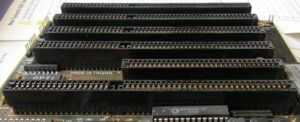
Expansion slots
One big advantage the 5150 PC had over the rest of the computers of the time was that there was an expansion bus that provided slots for different cards to connect to extend the features of the computer. Back in those days the Industry Standard Architecture bus in the PC was 8-bit, but soon grew to 16-bit.
The 32-bit market caused trouble with some manufacturers opting for a longer connector called Extended ISA (EISA), IBM with it’s Micro Channel Architecture (MCA) and Intel’s Peripheral Channel Interconnect (PCI) suffice to say, Intel’s PCI bus won out.
The PCI bus would briefly be replaced by Accelerated Graphics Port (AGP) and then with the move to serial communication PCIe.
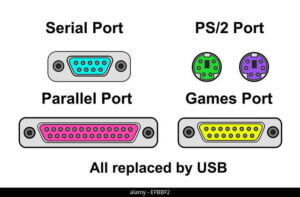
Printer and serial ports
Originally these were provided using expansion cards, the parallel port was devised by An Wang who was one of the team behind the low cost printer at Centronics that created the parallel printer standard in 1970.
The serial port came out in the 1960s, with the Recommended Standard (RS) 232 but by the 1980s these appeared on the PC. RS232 is still used, although RS422, RS423 and RS485 are more often used in industrial applications. RS485 is the standard used in vehicles to communicate between devices.
In 1995, 7 computer companies got together to create the Universal Serial Bus which was released in January 1996 which would eventually bring an end to serial and parallel ports on the PC.
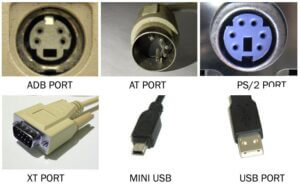
The keyboard
The original 5150 PC keyboard and the PC-AT keyboard shared the same 5-pin DIN connector and was known as the AT connector. Later IBM’s PS/2 connector became the standard for both keyboard and mice until the advent of USB.
On the early Macs, the Apple Desktop Bus was a network interface that allowed the keyboard and mouse to be connected to a computer. However, a badly connected device could crash the network.

The mouse
The trackball was developed in 1946 by Ralph Benjamin for use with the WW2 RADAR plotting system and patented in 1947, however it was kept as a military secret.
The first mouse was developed in 1964 by SRI Industries’ Douglas Engelbart. With the first computer to use a mouse being the Alto in 1973, which is where Steve Jobs of Apple and Bill Gates of Microsoft witnessed the mouse. Apple released the mouse with the Apple Lisa in 1983 and later Microsoft released their mouse in 1983 but they weren’t popular until Apple released the Apple Macintosh 128K in 1984 and both Amiga released their 1000 and Atari the ST in 1985.
In the early mouse days, there were several standards that came out with different connectors which were gradually replaced with the PS/2 mouse connector before being replaced by USB.
Joystick Game Port
The Joystick was patented in 1936 by C B Mirik of the US Naval Research Laboratory but the “Game Control Adapter” was released by IBM in 1981 as an accessory card. Although there were joysticks in use prior to IBM’s adapter, they were non-standard and IBM set the standard going forward with it’s 15 pin connector.
In 1989, Creative Technology created the SoundBlaster which was a sound card with a Joystick port that doubled up as a MIDI (Musical Interface Digital Input) connection.
In 1996, the advent of the USB port began to phase out the game port.
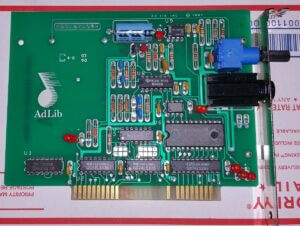
Sound Card
The sound card was developed in 1972 by Sherwin Gooch of Gooch Synthetic Woodwind but the IBM PC didn’t have a sound card, instead it had a speaker that was never designed to play music or speech, it was designed to play warning tones to the user.
The first sound card was the AdLib which enabled the playback of music and speech in 1987. In 1989, Roland released the MT-32 for MIDI for the music industry.
MIDI is more akin to digital sheet music, as it is the notes an instrument will play rather than the sound of the actual instruments.
In the late 1990s, computer manufacturers started integrating sound cards into their computers and by 2000, quality sound chips made their way to motherboards.

Graphics card
Graphics had been developed in the 1940s for the Whirlwind 1 flight simulator.
IBM in 1965 created the 2250 monitor that a user could draw on the screen using a light pen to draw vector graphics.
It was Alan Kay that used graphics as a programming language in the first Graphical User Interface (GUI) at Xerox Palo Alto Research Center (PARC) with the Alto in the 1970s. This is the basis for what Apple’s Mac OS and Microsoft Windows comes from.
In the 1980s however, IBM needed a card for their PC to display on their 5151 monitor so they created the Monochrome Display Adapter or MDA.
Later IBM developed a 4 colour system they called Color Graphics Adapter (CGA). Following this came the Extended Graphics Array (EGA) which allowed for more dots on the screen and 16 colours. From that Video Graphics Array allowed for 256 colours at 320×200.
In the 1990s, IBM released the Extended Video Graphics Array (EVGA) which could cater for 1024×768 and 256 colours then Super Video Graphics Array which could deliver 16.7 million colours.
Intel developed the Accelerated Graphics Port which could display up to 2K (2048×1536) and 16.7 million colours.
Intel released their PCI bus and AGP was phased out.

Networking
Back in the 1970s, there were two conflicting Local Area Networks (LANs) developed, the first called the Cambridge Ring by the University of Cambridge and the second Ethernet by PARC.
Ethernet consisted of a thick coaxial cable known as 10Base-5 which was terminated at both ends with a maximum length of 500m. Later 10Base-2 was developed with a thinner coaxial cable and a maximum length of 185m but could be connected to 10Base-5 for longer runs. Additionally network cards could be connected using an Attachment Unit Interface or AUI to other network types including 10Base-T.
10Base-5 and 10Base-2 were network buses which had to connect each computer in a chain like a bus route, but 10Base-T was a star network which used a central distribution point and each computer had it’s own connection to that point.
As technology improved, 10Base5 and 10Base2 became obsolete and 100Base-T and 1000Base-T are now common wired network connections. 2.5GBase, 5GBase and 10GBase are also available.
The advent of Wireless networking has made life easier for everyone, that and Bluetooth for lower speed devices to communicate.

